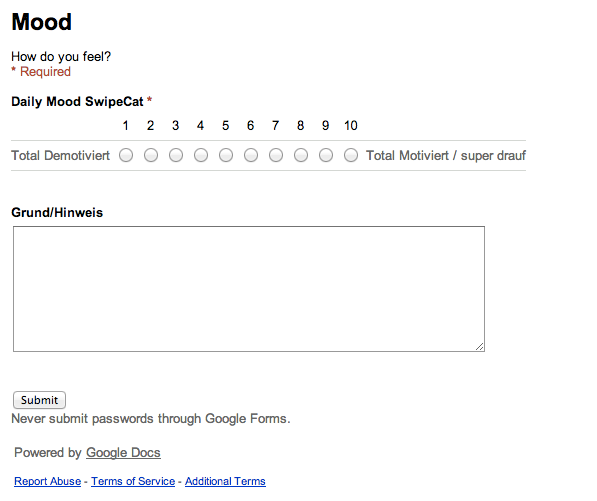Almost 2 years ago – when I started working on my first own startup back in Munich – I was lucky to meet Florian Schumacher on a networking event. He was and is one of the most involved persons in the German quantified self community I know (in fact he founded Quantified Self Germany). Back in 2012 he explained me his passion saying “I just love sensors and enjoy measuring stuff”. By now he’s actively involved in the German Quantified Self community and was interviewed by several newspapers, radios and other blogs. Being one of the early adopters of the quantified self trend in Europe he was already then testing a lot – starting from heart frequency to sleep tracking way before someone would know about Jawbone or Fitbit.
Only short time before that meeting I started to think about how to be able to reflect more on my personal situation and daily mood and set it in context to what’s happening around me. Working full time in my own company while finishing my degree at night (on Uberman sleep) my mood was like a roller coaster anyway.
Getting started – Version 1 of the moodsheet
Meeting and talking to Florian encouraged me to put more thoughts into this. That was when I created my daily moodsheet. It was a very simple hack, a Google form consisting of a scale from 1 to 10 and an input field. I created a shortened link to that doc and set me two reminders every day to fill it out – one at 11am and one at 6pm. Using the scale I would reflect on and determine my current mood and mental situation. 1 would be totally demotivated/frustrated, 10 would be very euphoric and happy. The input field would serve for additional information about what was going on that particular day.
I did this for 1 1/2 years from that day onwards. Sometimes more, often less frequently. It became a daily habit by now.
Level up – Pimping the moodsheet
In January this year I decided to eventually pimp the moodsheet as I was missing additional factors to differentiate the influences on my mood. The result is now way more complex, but also gives me a lot more detailed information about how I am feeling mentally, physically, motivational and what reasons that could have. In fact, it doesn’t tell me the reasons but I can see certain correlations. I added a bunch of quantitative fields such as stress level, physical training, healthy food, hours of sleep, sex as well as qualitative fields to define what’s happening, what I learned and if I left my comfort zone that day.
I also added my daily learnings to the sheet – something that became very valuable for me to reflect upon: I helps me to stop in my daily flow for a couple of seconds and forces me to think what I reached today, what things I’ve learned and urges me to put these things into words. The latter is something not that easy if you think about it. Understanding something is always easier than actually explaining it to someone (to something – a google spreadsheet – in this case).
In homage to Hans, a fellow StartupBus conductor, I added a “Did you leave your comfort zone today?” box today 😉
Resources
I published a copy of my moodsheet in english here. Feel free to copy it (via File —> Make a copy – make sure not to share it with other people).
In fact, although Google offers a nice visualisation for the form responses, I have hardly looked (not more than twice) at the data at all in the last 2 years. Still, it is a very valuable tool for my self-reflection.
Do you have any feedback or suggestions? Do you use any tools to reflect upon yourself?
Leave me a comment below!



Pingback: What I learned from emotional tracking - Bobolland.com